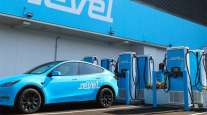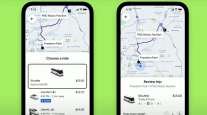Bloomberg News
Uber Bookings Climb 24% on Strong Growth in Delivery

[Stay on top of transportation news: Get TTNews in your inbox.]
Uber Technologies Inc. reported a 24% increase in gross bookings in the first quarter, driven by continued growth in the delivery business.
The total value of customer spending on Uber reached $19.54 billion, exceeding an average of analysts’ estimates compiled by Bloomberg. But the performance was blunted by a revenue decline, due largely to a $600 million expense from reclassifying workers in the U.K. The stock rose about 1% in extended trading.
The San Francisco-based ride-hailing and delivery company narrowed its adjusted loss, Uber said in a statement May 5. It was $359 million before interest, tax and other expenses, easily beating analysts’ estimates. The loss was 6 cents a share.

The year is 2039. Zero-emission, electric heavy-duty trucks roll past you on the highway. Charging ports are now commonplace at terminals and truck stops. Diesel-powered vehicles are becoming a thing of the past. You sit and wonder: How did we get here? Here, in 2021, Daimler Trucks North America's head of eMobility speaks to RoadSigns. Hear a snippet above, and get the full program by going to RoadSigns.TTNews.com.
The company trimmed costs considerably in the coronavirus pandemic. It cut staff and sold businesses, including a pricey, yearslong effort to develop self-driving car technology.
Now Uber is searching for new ways to get people into the back seats of its cars. It added a new feature to the app a week ago for booking vaccine appointments and transportation to a nearby Walgreens and back. Gross bookings from the mobility business were $6.8 billion in the first quarter, more than analysts expected.
Making customers comfortable with riding in strangers’ cars is only one part of the equation. Many drivers switched to other jobs or stayed at home when the coronavirus wiped out ride-hailing demand. Now the company is trying to get drivers back. Uber said last month it would spend $250 million on bonuses and other incentives. It said May 5 that the program contributed to increased costs in the first quarter.
Lyft Inc., the main alternative to Uber in the U.S., reported financial results May 4. The company said ridership demand rebounded from the prior quarter and that its loss narrowed.
Almost as much as the pandemic wounded the rides business, it was a catalyst for Uber’s delivery operation. The company quickly expanded from meals to booze, groceries, packages and prescriptions. On May 4, Uber said it will add convenience store items for delivery from GoPuff, a fast-growing startup.
“We believe consumer behavior around delivery is likely to prove sticky as Uber Eats offers a better product today than prepandemic,” wrote Ron Josey, equity research analyst at JMP Securities, in a note to clients.
Delivery revenue rose another 28% from the prior quarter to $1.7 billion. That’s more than triple what it was a year ago.
However, Uber’s financial performance was impacted by a landmark ruling in the U.K. The company agreed to grant some government-mandated benefits to its drivers, resulting in the $600 million expense, which weighed on revenue and added to its loss. Sales fell 11% to $2.9 billion. Excluding that cost, revenue grew 8%.
Want more news? Listen to today's daily briefing below or go here for more info:




